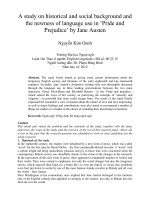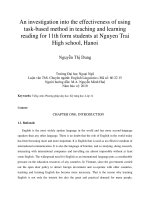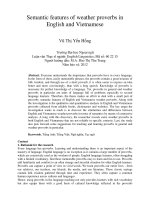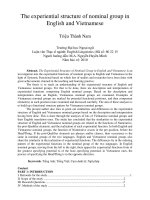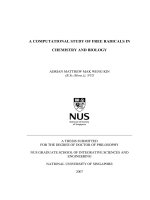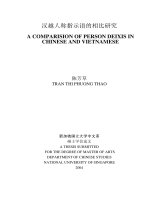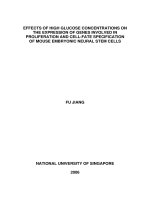Uses of geothermal energy in food and agriculture bopportunities for developing countries
Bạn đang xem bản rút gọn của tài liệu. Xem và tải ngay bản đầy đủ của tài liệu tại đây (2.6 MB, 62 trang )
Uses of
geothermal
energy
in food and
agriculture
Opportunities
for developing
countries
Minh Van Nguyen
Sigurjón Arason
Margeir Gissurarson
Páll Gunnar Pálsson
Uses of
geothermal
energy
in food and
agriculture
Opportunities
for developing
countries
FOOD AND AGRICULTURE ORGANIZATION
OF THE UNITED NATIONS
Rome, 2015
Recommended citation
Van Nguyen, M., Arason, S., Gissurarson M. and Pálsson, P.G. 2015. Uses of geothermal
energy in food and agriculture – Opportunities for developing countries. Rome, FAO.
Cover photos
Geyser in Yellowstone National Park – ©Monica Umena
Krafla Geothermal Power Plant (Iceland) – ©ThinkGeoEnergy
Greenhouse in Iceland – ©FAO/Carlos da Silva
Drying of papaya – ©FAO/Alastair Hicks
The designations employed and the presentation of material in this information product do not imply the
expression of any opinion whatsoever on the part of the Food and Agriculture Organization of the United
Nations (FAO) concerning the legal or development status of any country, territory, city or area or of its
authorities, or concerning the delimitation of its frontiers or boundaries. The mention of specific companies
or products of manufacturers, whether or not these have been patented, does not imply that these have
been endorsed or recommended by FAO in preference to others of a similar nature that are not mentioned.
The views expressed in this information product are those of the author(s) and do not necessarily reflect the
views or policies of FAO.
The designations employed and the presentation of material in the map(s) do not imply the expression of
any opinion whatsoever on the part of FAO concerning the legal or constitutional status of any country,
territory or sea area, or concerning the delimitation of frontiers.
ISBN 978-92-5-108656-8
© FAO, 2015
FAO encourages the use, reproduction and dissemination of material in this information product. Except
where otherwise indicated, material may be copied, downloaded and printed for private study, research
and teaching purposes, or for use in non-commercial products or services, provided that appropriate
acknowledgement of FAO as the source and copyright holder is given and that FAO’s endorsement of users’
views, products or services is not implied in any way.
All requests for translation and adaptation rights, and for resale and other commercial use rights should be
made via www.fao.org/contact-us/licence-request or addressed to
FAO information products are available on the FAO website (www.fao.org/publications) and can be
purchased through
iii
Contents
Foreword
vi
Preface
vii
About the authors
ix
Acknowledgements
x
Chapter 1
Introduction1
Chapter 2
Geothermal energy: an overview
2.1Basic concepts
2.2 Uses around the world
2.3 Geothermal energy utilization
2.4 Geothermal energy exploitation
2.5 Availability and use in developed and developing countries
Chapter 3
3
3
5
8
10
11
Geothermal uses in practice
27
3.1Greenhouses
3.2 Sea/brackish water greenhouses
3.3 Soil heating
3.4Aquaculture
3.5 Algae cultivation
3.6 Food drying
3.7 Milk pasteurization
3.8 Preheating and heating processes
3.9 Evaporation and distillation processes
3.10 Peeling and blanching processes
3.11 Sterilization processes
3.12 Irrigation using geothermal water
27
30
30
31
33
33
34
36
36
36
39
39
Chapter 4
Role of the public sector
Chapter 5
41
Constraints and challenges
43
5.1 Policy and regulatory barriers
5.2 Technical barriers
5.3 Financial barriers
43
43
43
iv
Chapter 6
Conclusions45
References47
FIGURES
1. Temperatures of the earth’s crust, mantle, outer core
and inner core layers
2. Major locations of geothermal activity around the world
3. Formation of a geothermal reservoir
4. Locations of geothermal operations around the world
5. A geothermal power plant cycle
6. Lindal diagram of potential uses of geothermal energy
in the agriculture and agro-industry sectors
7. Cascading from a geothermal power plant
8. Agricultural and agro-industrial uses of geothermal
energy in Europe
9. Cabinet dryer for drying chillies and garlic
10. Convective geothermal rice dryer
11. Fruit dryer using geothermal energy in Los Azufres, Mexico
12. Geothermal dryer for drying beans and grains
13. Conveyor dryer using geothermal energy
14. Batch grain dryer using geothermal energy
15. Rack tunnel dryer using geothermal energy for fish drying
16. Conveyor dryer using geothermal energy for fish drying
17. Common shapes of greenhouse
18. Horizontal hot water unit heater
19. Vertical hot water unit heater
20. Soil heating systems for greenhouses
21. Heating pipe distribution for a soil warming system
inside a greenhouse
22. Fish farming using geothermal energy
23. Geothermal heat exchanger
24. Milk pasteurization using geothermal hot water
25. Fluid flows through a plate heat exchanger
26. Twin-shell heating tank with spiral tubes
27. Heating tank with internal spiral or zigzag tubes
28. Forced circulation evaporator
29. Multi-evaporator using geothermal energy
3
4
4
5
6
9
10
12
16
17
18
19
19
20
21
22
28
29
29
30
31
32
33
34
35
37
37
38
39
v
PHOTOS
1.
2.
3.
4.
5.
6.
7.
8.
9.
Tomatoes loaded on drying racks in Greece
Pilot-scale cotton dryer using geothermal energy in Greece
Fish drying in a geothermal tunnel dryer in Iceland
Fish backbones dried in a conveyor dryer using geothermal
energy in Iceland
Secondary drying of fish in containers in Iceland
Polyethylene heating tubes in a plastic-covered greenhouse
for vegetable cultivation (left), and polypropylene heating tubes
laid on the soil in a glass-covered greenhouse (right) in Greece
Tomato cultivation in a greenhouse in Iceland
Cucumber cultivation in a greenhouse in Iceland
Raceway pond for cultivation of spirulina using geothermal
energy in Nigrita, Greece
14
15
21
23
23
24
25
25
26
Tables
1. Top ten countries for use of geothermal energy
in power generation, 1990–2010 and 2015 forecast
2. Categories of direct use worldwide, 1995–2010
3. Top ten countries for direct use of geothermal energy
4. Direct uses of geothermal energy in developing countries
5. Legislation concerning geothermal development approved
by the Government of Kenya
6
7
8
13
42
vi
Foreword
As Planet Earth moves towards the challenge of feeding 10 billion people, we can
seek guidance from the pioneering developments in Iceland and some other parts of
the world in using the heat stored inside our planet to enhance the food security of
nations on every continent.
The challenge has two dimensions: how to store successfully the food already
produced, and how to enhance production without harming the environment.
The solutions to both are outlined in this ground breaking report, drawing on
existing technologies and profitable business practices.
The drying of food products using geothermal heat or other clean energy
resources, based on four decades of Icelandic experience, could enable people all
over the world to utilize commercially food that is currently either thrown away
or spoiled due to lack of suitable storage facilities. If applied extensively on a global
scale, drying could increase the availability of food by up to 20 percent. No other
single method holds such potential.
The development of greenhouse agriculture and geothermal-based aquaculture in
my country also demonstrates how sustainable energy can increase food production
considerably, giving farmers and fishermen new ways to earn a living.
By commissioning this report, FAO has significantly strengthened the emerging
global coalition of international institutions and national leaders determined to
explore fully how the rich geothermal resources of Planet Earth can make a substantial contribution to improving food security all over the world in the decades
to come.
Ólafur Ragnar Grímsson
President of Iceland
vii
Preface
Access to reliable supplies of energy is one of the main preconditions for the
development of agrifood industries and is a key determinant of their competitiveness. With growing concern about climate change and the need to reduce the use of
fossil fuels, there is increasing interest in the use of renewable energy. In this regard,
geothermal energy is one of the options that can be exploited in countries that are
endowed with this resource.
Traditionally, geothermal energy has been utilized for the most part in power
generation. However, there are examples of successful applications in other, nonpower generation uses, particularly in the food and agriculture sector. Its potential
uses in the agrifood domain were highlighted by H.E. Ólafur Ragnar Grímsson,
President of the Republic of Iceland, who during a visit to FAO Headquarters in
Rome, Italy, in March 2011, underscored the experience of his country in the use of
geothermal energy for agricultural and food processing purposes and the benefits
that Iceland had gained in this regard. This was seen as a unique experience that
FAO could help promote in other countries that are endowed with geothermal
resources, especially in the developing world, as a way of promoting food security
and economic development.
As a follow-up to the visit, FAO undertook a mission to Iceland in October
2011 to obtain first-hand knowledge of geothermal uses in the agrifood sector and
to explore approaches to extending this technology to the developing world. The
mission, comprising agroprocessing and agribusiness experts, visited public sector
agencies, research institutes, university programmes, private consulting companies
involved in geothermal resource exploitation and utilization, and private sector
enterprises utilizing this energy source for non-power generation applications. The
mission was exposed not only to technical installations for generation and utilization, but also to the institutional, policy and regulatory framework required for
successful exploitation of geothermal energy in the agrifood sector.
As an outcome of the mission and its follow-up appraisals and consultations,
FAO has strengthened its conviction that there is very good potential for numerous
developing countries to harness geothermal resources with a view to promoting
the development of their food and agriculture sector. These countries are located
primarily in Central America, the Pacific coast of South America, the Rift Valley
in Africa and the islands of southeastern Asia. All can benefit from the utilization
of geothermal energy in attaining sustainable food and nutrition security through
increased crop and fisheries production, better food preservation and storage, and
reduction of losses and waste along the food chain.
This publication was commissioned by FAO with a view to furthering the
process of awareness raising, information dissemination and advocacy to promote
geothermal energy uses in food and agriculture. The document provides guidance
on potential approaches, lessons, constraints and factors to be considered in devel-
viii
oping geothermal energy applications for agrifood industry development, paying
particular attention to technical, policy and economic considerations.
It is hoped that the publication will be valuable to professionals from the public
and private sectors, development agencies and financial institutions with an interest
in promoting renewable energy uses in food and agriculture.
José Graziano da Silva
Director-General, FAO
ix
About the authors
Minh Van Nguyen is a lecturer and researcher at the Faculty of Food Technology, Nha Trang University, Viet Nam, where he has been working since 2000. He
did his Ph.D. studies at the Faculty of Food Science and Nutrition, University of
Iceland, and was post-doctoral researcher at Matís ltd.-Icelandic Food and Biotech
R&D (Matís).
Sigurjón Arason is a Chief Engineer at Matís and a Professor at the University of
Iceland, where he teaches food engineering and fishery processing. He is one of the
leading researchers in Icelandic fisheries and the processing of fish products. He also
teaches at the United Nations University (UNU) Geothermal Training Programme
in the use of geothermal heat in the fish industry and drying, and at the UNU Fisheries Training Programme in seafood processing.
Margeir Gissurarson is a Project Manager in the Analysis and Consulting Division at Matís. He has been a Project Manager of fisheries projects in Mozambique,
for the Icelandic International Development Agency (ICEIDA), and a Division
Manager for Icelandic Freezing Plants. He is currently a part-time lecturer at the
University of Iceland.
Páll Gunnar Pálsson is a Project Manager in the Business Development Division at
Matís. He has been a Project Manager in product development at Icelandic Freezing
Plants in Iceland and Hamburg, Germany, a Quality Manager in fish processing and
a Production Manager in a canning factory.
x
Acknowledgements
This publication has been prepared by a team of professionals associated with Matís
ltd.-Icelandic Food and Biotech R&D, following the conceptualization and editorial
oversight of Carlos A. da Silva (Senior Agribusiness Economist, FAO Rural Infrastructure and Agro-Industries Division, [AGS]) and Divine Njie (Deputy Director,
FAO AGS).
The editors wish to express their special gratitude to the representatives of the
Government of the Republic of Iceland who collaborated on this project. We are
grateful to H.E. Ólafur Ragnar Grímsson, President of the Republic of Iceland, for
drawing our attention to, and sharing his deep knowledge of, geothermal energy
and its potential uses as drivers of economic and social development. We also thank
Guðni Bragason, former Minister Plenipotentiary/Permanent Representative of the
Republic of Iceland to FAO, WFP and IFAD, for his engagement in the project and
for facilitating our access to the many Icelandic institutions and professionals with
expertise in the areas covered by this publication.
We are grateful to Modibo Traoré, former Assistant Director-General of FAO’s
Department of Agriculture and Consumer Protection, for steadfastly supporting
the follow-up to the visit of H.E Grímsson to FAO, as well as to Gavin Wall and
Eugenia Serova, former and current Directors of FAO AGS, for their support to
this initiative.
Appreciation is extended to Danilo Mejía-Lorio, Joseph Mpagalile, Yvette Diei
and Olivier Dubois of FAO, who kindly peer-reviewed the manuscript, and to
Larissa D’Aquilio (FAO AGS) for production coordination, Jim Collis and Jane
Shaw for copy editing, Monica Umena for the design, and Lynette Chalk for the
proofreading.
The Editors
1
Chapter 1
Introduction
Two billion people – one in every three of the world’s population – lack access
to modern energy services (Fridleifsson, 2001). Between 1990 and 2050, primary
energy consumption is expected to increase by at least 50 percent, and by as much
as 275 percent under the highest growth scenario (World Energy Council, 2002).
The generation of energy from naturally replenished sources such as wind, rain,
sunlight, tides, waves and geothermal water and steam is therefore set to become
increasingly important (Fatona, 2011). Access to clean, affordable energy is seen
as key to improving the living standards of the world’s poor people (Fridleifsson,
2001). By 2100, renewable sources are expected to be providing 30–80 percent of
total energy consumption (Fridleifsson, 2001, 2013).
Geothermal energy is one of the most important energy resources for electricity
generation and is also used directly in heating, food and agriculture, aquaculture
and some industrial processes (Dickson and Fanelli, 2004). It is stored as heat in the
magma, or molten rock, of the earth’s interior, where temperatures are extremely
high; in hot water and rocks several kilometres below the earth’s surface; and – in
some parts of the world – in shallow ground (Barbier, 2002).
The earliest reported use of geothermal energy dates from the pre-pottery period, before 11000 BC, when people in Japan were using hot springs for bathing and
washing clothes (Sekioka, 1999). There is also archaeological evidence of geothermal
energy being used in North America more than 10 000 years ago (Solcomhouse, no
date), and its use in China has been recorded for more than 2 000 years (Fridleifsson,
2001). Industrial use started in the late eighteenth century, when steam from under
the ground was used to extract boric acid from volcanic mud near what is now the
town of Larderello in Tuscany, Italy. Just over a century later, in 1904, the world’s
first geothermal power generator was tested at Larderello by Italian scientist Piero
Ginori Conti, using steam to generate electricity (Conserve Energy Future, no
date). Since then, geothermal energy has been put to a wide range of uses in space
heating and cooling, industry, horticulture, fish farming, food processing and health
spas (Fridleisson, 2001).
Agriculture and agro-industry are still major economic sectors in most developing countries, where they are the main source of livelihoods for 75 percent of the
poor (FAO, 2009). However, the people in these countries face famine and poverty,
mainly as a result of post-harvest losses and the lack of affordable energy for aquaculture and food processing. Estimates of post-harvest losses (in weight and quality)
in developing and less developed countries range from 1 to more than 50 percent
(National Academy of Sciences, 1978; Hodges, Buzby and Bennett, 2011). A recent
FAO study (FAO, 2011) calculates that the agriculture and food sector’s share in
total energy consumption is 30 percent, of which more than 70 percent is consumed
2
Uses of geothermal energy in food and agriculture – Opportunities for developing countries
beyond the farmgate. The sector also accounts for about 22 percent of total greenhouse gas emissions, including landfill gas produced from food wastes, and about
38 percent of all the energy consumed along the food chain is embedded in annual
global food losses (FAO, 2011). The unsatisfied demand for a sustainable supply of
affordable energy is therefore a major constraint to development of the agriculture
and agro-industry sectors in developing countries.
This publication summarizes the current status of geothermal energy use in
agriculture and agro-industry sectors around the world and seeks to provide developing countries with guidance on how to utilize geothermal energy to develop their
agriculture and agro-industry sectors. The book is organized according to a simple
format with illustrations, graphs and models of geothermal energy use for easy reference to help non-technical readers to increase their understanding of geothermal
energy and its possible future applications.
3
Chapter 2
Geothermal energy: an overview
2.1 Basic concepts
What is geothermal energy?
Geothermal energy is a clean, sustainable and renewable resource that provides
energy using heat derived from the earth. Radioactive elements within the earth
release heat at very high temperatures, which increase depending on the distance
from the earth’s surface (Figure 1). The temperature of the earth’s core is estimated
to be about 5 000 °C, and the outer core is about 4 000 °C – a similar temperature
to that on the surface of the sun (Figure 1). The constant flow of heat energy from
the earth’s interior, equivalent to an estimated 42 million megawatts (MW) of power,
is expected to continue for billions of years (Íslandsbanki, 2011).
Where is geothermal energy found?
Geothermal activity is concentrated around the Pacific Ocean and the Pacific Plate
(Figure 2), in the “Ring of Fire” that reaches from Indonesia, the Philippines and
Japan, to Alaska, Central America, Mexico, the Andes and on to New Zealand.
Geothermal energy usually remains deep underground, but sometimes reaches
the surface as hot springs and geysers, or volcanoes and fumaroles (holes created
figure 1
Temperatures of the earth’s crust, mantle, outer core and inner core layers
40 km
2 690 km
4
00
0
5 150 km
°C
5
0
00
°C
Crust
Source: P.G. Pálsson, 2013.
Mantle
Outer core
Inner core
6 370 km
Uses of geothermal energy in food and agriculture – Opportunities for developing countries
4
figure 2
Major locations of geothermal activity around the world
Iceland
Italy
Japan
China
Ethiopia
ng
Philippines
Kenya
United States
of America
Ri
of
Mexico
Fi
re
Indonesia
Australia
New Zealand
Source: P.G. Pálsson, 2013. (Based on UN map No. 4170 Rev. 13, April 2012. Department of Field Support, Cartographic Section).
figure 3
Formation of a geothermal reservoir
Rainwater
Hot water
Hot rock
Source: P.G. Pálsson, 2013.
Hot rock
Chapter 2 – Geothermal energy: an overview
5
when volcanic gases are released), particularly in the high-temperature geothermal
fields located along the major plate boundaries (Serpen, Aksoy and Ongur, 2010;
Fridleifsson et al. 2008).
An important exploitable source of geothermal energy are the reservoirs that
form underground when groundwater trapped along fault lines, fractures in rock
and porous rock is heated by magma that has been pushed up from the earth’s core
(Figure 3). Geologists looking for these hydrothermal resources usually have to drill
deep wells to find them (Serpen, Aksoy and Ongur, 2010).
2.2 Uses around the world
All over the world, naturally occurring steam and hot water are being used to generate electricity, provide heating and hot water for domestic and other uses, and drive
industrial processes such as drying and concentrating (Burgess, 1989; Ghomshei,
2010; Gunerhan, Kocar and Hepbasli, 2001; Lund, 2010). Geothermal heat pumps,
which use geothermal energy to heat and cool buildings, form the largest category
of direct applications, followed by domestic hot water, swimming pools and space
heating (Lund, Freeston and Boyd, 2010). Most of Iceland’s electricity and heating
needs are supplied from its abundant geothermal energy resources. Other countries
deriving more than 10 percent of their electricity from geothermal sources include
Costa Rica, El Salvador, Kenya, New Zealand and the Philippines.
At present, 24 countries use geothermal power to generate electricity, and
another 11 are developing and testing geothermal systems, including Australia,
France, Germany, Japan, Switzerland and the United Kingdom of Great Britain
figure 4
Locations of geothermal operations around the world
Iceland
Italy
United States
of America
Mexico
China
Central America
Japan
Philippines
Ethiopia
Kenya
Indonesia
New Zealand
Source: P.G. Pálsson, 2013. (Based on UN map No. 4170 Rev. 13, April 2012. Department of Field Support, Cartographic Section).
Uses of geothermal energy in food and agriculture – Opportunities for developing countries
6
and Northern Ireland (Figure 4) (British Geological Survey, no date). Worldwide,
an estimated 67 000 gigawatt hours (GWh) of electricity is generated from a total
installed geothermal power capacity of about 10 700 MW. The United States of
America accounts for about 30 percent of this installed capacity, with 3 100 MW,
followed by the Philippines, Indonesia and Mexico (Table 1) (Íslandsbanki, 2011).
Table 1
Top ten countries for use of geothermal energy in power generation, 1990–2010 and 2015 forecast
Year
Installed capacity in megawatts
Philippines
United
States
283
891
2 775
753
286
1 227
2 817
45
755
437
1 909
2 228
535
129
953
435
1 930
2 564
811
535
129
953
472
1 970
2 924
1 197
863
536
167
958
628
1 904
3 087
3 500
920
535
530
1 140
1 240
2 500
5 400
El
Salvador
Iceland
Indonesia
Italy
Japan
Kenya
Mexico
1990
95
45
145
545
215
45
700
1995
105
50
310
632
414
45
2000
161
170
590
785
547
2005
151
202
797
791
2007
204
421
992
2010
204
575
2015
290
800
New
Zealand
Source: Íslandsbanki, 2011.
figure 5
A geothermal power plant cycle
Satellite site
Plant station
Well site
Injection well
Power plant
Source: P.G. Pálsson, 2013.
Chapter 2 – Geothermal energy: an overview
7
There are three main categories of geothermal power plant, depending on the
chemistry, fluid temperature and pressure involved: i) condensing power plants,
with dry steam and single- or double-flash systems; ii) back-pressure turbines,
which release into the atmosphere; and iii) binary plants, which use lowertemperature water or separated brine (Mburu, 2009). Figure 5 illustrates a typical
geothermal power plant cycle.
The direct utilization of geothermal energy is well documented; people have
been using hot springs for cooking and therapeutic purposes for thousands of years.
Today, low- to moderate-temperature (20–150 °C) geothermal reservoirs provide a
relatively cheap and pollution-free source of energy for direct uses (NREL, 1998).
Table 2
Categories of direct use worldwide, 1995–2010
Utilization category
1995
2000
2005
2010
Geothermal heat pumps
1 853
5 275
15 384
33 134
Space heating
2 579
3 263
4 366
5 394
Greenhouse heating
1 085
1 246
1 404
1 544
Aquaculture pond heating
1 097
605
616
653
67
74
157
125
544
474
484
533
1 085
3 957
5 401
6 700
Cooling/snow melting
115
114
371
368
Others
238
137
86
42
8 664
15 145
28 269
48 493
Geothermal heat pumps
14 617
23 275
87 503
200 149
Space heating
38 230
42 926
55 256
63 025
Greenhouse heating
15 742
17 864
20 661
23 264
Aquaculture pond heating
13 493
11 733
10 976
11 521
1 124
1 038
2 013
1 635
Industrial uses
10 120
10 220
10 868
11 745
Bathing and swimming
15 742
79 546
83 018
109 410
Cooling/snow melting
1 124
1 063
2 032
2 126
Others
2 249
3 034
1 045
955
112 441
190 699
273 372
423 830
Capacity (megawatt thermal)
Agricultural drying
Industrial uses
Bathing and swimming
Total
Utilization (terajoules/year)
Agricultural drying
Total
Source: Lund, Freeston and Boyd, 2011.
8
Uses of geothermal energy in food and agriculture – Opportunities for developing countries
Table 3
Top ten countries for direct use of geothermal energy
Country
Annual use (terajoules/year)
China
75 348
United States of America
56 552
Sweden
45 301
Turkey
36 886
Norway
25 200
Iceland
24 361
Japan
15 698
France
12 926
Germany
12 765
Netherlands
10 699
Source: Lund, Freeston and Boyd, 2011.
These geothermal reservoirs are reached via 1 000–3 000-m deep wells. Currently,
about 73 countries around the world make direct use of a total geothermal energy
output of 75.9 terawatt hours (TWh) per year, and the number of countries using
geothermal energy for direct applications is increasing steadily (Mburu, 2009). The
categories of direct utilization of geothermal energy in the period from 1995 to 2010
are presented in Table 2, and the top ten countries for the direct use of geothermal
energy in Table 3.
2.3 Geothermal energy utilization
Lindal diagram
The potential uses of geothermal energy in the agriculture and agro-industry sectors
are summarized in Figure 6, which is an adapted Lindal diagram. In direct applications, geothermal reservoirs of low to intermediate temperature (20–150 °C) are
exploited, mainly in heat pumps for heating and cooling, space heating, pools and
spas, greenhouses, aquaculture and industrial processes. High-temperature geothermal reservoirs (150–300 °C) are exploited for indirect use applications, including
steam and electricity production (conventional electric generation) (Islandsbanki,
2011). Electricity is also generated using intermediate-temperature (70–149 °C)
geothermal resources (and binary electric generation). The electricity from conventional or binary power plants is used in industrial processes, and hot water from
binary power plants can be used for direct applications (Ogola, Davidsdottir and
Fridleifsson, 2012). Steam and superheated water are normally used in certain agroindustrial processes that require high temperatures, although lower temperatures
can sometimes be used, especially for drying agricultural products (Lund, 1996).
Chapter 2 – Geothermal energy: an overview
9
figure 6
Lindal diagram of potential uses of geothermal energy in the agriculture
and agro-industry sectors
Direct use
Low-temperature resources
0
10
20
30
40
Indirect use
Intermediate-temperature resources
50
60
70
80
90
100
110
High-temperature resources
120
130
140
150
160
170
180
190 .... 300
°C
Aquaculture
Greenhouse heating
Food processing
Equipment
sterilization
in meat
processing
Mushroom culture
Pickling
Fishmeal and
timber drying
Beet sugar extraction
Fruit wine making
Sterilizing
Pasteurization
Personal
hygiene/
laundry in
meat
processing
Soil warming
Malt bewerage
Distilled liqours
Sugar evaporation
Milk evaporation
Boiling
Fruit and vegetables drying
Whey condensing
Beeswax
melting
Grains and
fish drying
Washing
Pre-heating and heating
Peeling and blanching
Evaporation and distillation
°C
0
10
20
30
40
50
60
70
80
90
100
110
120
130
140
150
160
170
180
190 .... 300
Source: P.G. Pálsson, 2013.
Sources of geothermal energy for agricultural and agro-industrial uses
Agricultural and agro-industrial uses form a very important part of geothermal
energy applications. In general, four types of direct application of geothermal
energy in agriculture can be identified (Popovski, 2009):
greenhouse heating;
aquaculture (fish farming and algae production);
agro-industrial processes;
soil heating (of open-field plant root systems).
The sources of geothermal energy for agricultural and agro-industrial uses include
low- and intermediate-temperature geothermal resources, as well as the waste heat
and cascading water from geothermal power plants (Figure 7).
10
Uses of geothermal energy in food and agriculture – Opportunities for developing countries
figure 7
Cascading from a geothermal power plant
Food processing
100 °C
Apartment
building
150 °C
Refrigeration
plant
Greenhouse
50 °C
200 °C
Power plant
15–20 °C
Fish farming
Source: Geo-Heat Center, Klamath Falls, Oregon (USA). Adapted with permission.
2.4 Geothermal energy exploitation
The preparation of geothermal energy exploration is divided into five phases:
1.First-phase surface exploration. Commonly used and relatively low-cost exploration methods are geothermal and geological mapping, geophysical surveying
and geochemical surveying, including sampling and analysis of natural outflows.
2.First-phase exploration drilling. If the first-phase surface exploration produces
positive results, the next step is to prove the existence of a geothermal reservoir
by drilling and testing. Although the cost of this phase is higher than that of
the surface exploration, more information about the geothermal field and the
pressure, temperature and chemical composition of the geothermal resources is
obtained. Normally, three to six wells are drilled during this phase.
3.Second-phase surface exploration – environmental impact assessment. A new reservoir model and further plans for surface exploration are designed based on the
information obtained during drilling of the exploration wells. At this stage, the
size of the reservoir and the potential power production capacity are estimated.
4.Second-phase exploration drilling. More wells are drilled to gather further
information prior to a financial investment decision.
5.Appraisal and operational phase. During operation, the geothermal resource
needs to be re-evaluated using data collected from existing wells. The sustainable
production capacity is also estimated to enable better planning for the future.
Chapter 2 – Geothermal energy: an overview
Potential impacts of geothermal energy development
The potential impacts of geothermal energy development depend on many factors,
such as the amount of land used for drilling, the construction activities implemented, and the number of well pads and the power plant technology applied. Among
the most important impacts of geothermal energy development are environmental
impacts, which include the following:
Gaseous emissions resulting from the discharge of non-condensable gases. The most
common gases are carbon dioxide (CO2), hydrogen sulphide (H2S) and other lowconcentration gases such as methane, hydrogen, sulphur dioxide and ammonia.
Water pollution. Dissolved minerals (e.g., boron, mercury and arsenic) contained
in the liquid streams generated during the exploration, stimulation and production
phases may poison surface or groundwater and harm local vegetation (Tester
et al., 2006). It is therefore important to monitor wells during drilling and
subsequent operations so that any leakage can be detected and managed rapidly.
Noise pollution. Primary sources of noise are associated with exploration
activities such as the well drilling, stimulation and testing phases, when noise
levels are in the range of 80–115 decibels at the site boundary. Noise levels drop
rapidly with increased distance from the source (Tester et al., 2006).
Geothermal energy development can also have impacts on agricultural resources,
mainly through land disturbance related to the construction of power plants and
transmission lines. It has impacts on ecological resources when construction activities destroy or injure wildlife, disturb breeding and migration patterns, and reduce
habitat quality and species diversity.
2.5Availability and use in developed and developing countries
Agricultural uses are a very important part of overall geothermal energy application.
The potential for this type of use has stimulated the direct application of geothermal
energy in many southeastern European countries (Figure 8) such as Greece, Hungary, Romania, Turkey and The former Yugoslav Republic of Macedonia (Popovski,
2009). Although geothermal energy resources also have high potential in developing
countries, they have been used mostly for space heating, bathing and swimming in
these countries. A few countries apply geothermal energy in the agriculture and
agro-industry sectors, including Algeria and Kenya in Africa, Costa Rica and El
Salvador in Central America, and China, India and Indonesia in Asia (Table 4).
Drying of agricultural products
Drying of agricultural products is a very important process in avoiding wastage
and ensuring that nutritious food is available all year round, and during droughts.
Low- to medium-enthalpy geothermal resources with temperatures less than 150 °C
(Muffler and Cataldi, 1978) are used because they have the highest potential for
agricultural drying applications (Ogola, 2013). The heat for drying can be obtained
from the hot water or steam of geothermal wells or by recovering waste heat from
a geothermal plant (Vasquez, Bernardo and Cornelio, 1992). The many advantages
of using geothermal energy rather than oil and electricity in food processing (Arason, 2003) include the far lower costs of using hot water or steam. The thermal
energy required for rice drying in The former Yugoslav Republic of Macedonia is
11
12
Uses of geothermal energy in food and agriculture – Opportunities for developing countries
figure 8
Agricultural and agro-industrial uses of geothermal energy in Europe
Iceland
Faeroe
Islands
Finland
Sweden
Norway
Estonia
United Kingdom
Irish
Republic
Latvia
Lithuania
Denmark
Russian Federation
Belarus
Netherlands
Belgium
Luxembourg
Poland
Germany
Czech Republic
Ukraine
Slovakia
Hungary
Rep.
of Moldova
France Switzerland
Romania
Slovenia Croatia
Serbia
Liechtenstein
Bosnia & Montenegro
Andorra
Herzegovina
Bulgaria
Monaco
Albania FYR Moldova
Italy
Spain
Austria
Portugal
Turkey
Georgia
Armenia
Azerbaijan
Greece
Malta
Greenhouse
Agro-industry
Cyprus
Aquaculture
Source: P.G. Pálsson, 2013. (Based on UN map No. 4170 Rev. 13, April 2012. Department of Field Support, Cartographic Section).
136 kilowatt hours (kWh)/tonne of wet weight (Popovski et al. 1992), while tomato
drying in Greece requires 1 450 kWh/tonne of wet weight (Andritsos, Dalampakis
and Kolios, 2003). Geothermal energy has been used to dry a wide range of agricultural products, such as rice, wheat, tomatoes, onions, cotton, chillies and garlic.
Tomato and cotton drying in Greece
A small-scale tomato drying plant located in Nea Kessani, Xanthi started operating
in 2001. Tomatoes are dried using geothermal hot water at 59 °C in a 14-m long
rectangular tunnel dryer (1 m wide and 2 m high). The tomatoes are sorted and
washed to remove dust, dirt, plant parts, etc. They are then cut in half and placed
on to stainless steel trays (of 100 cm2 × 50 cm2 mesh). Each batch of 25 trays is
dried for 45 minutes, with about 7 kg of raw tomatoes on each tray (Photo 1). The
dried tomatoes are then immersed in olive oil and ready for transport and sale.
During the first year of operation, 4 tonnes of high-quality dried-tomato products
were produced.
A pilot-scale geothermal drying system for the pre-drying of cotton was designed
and tested in Nea Kessani, Xanthi in 1991 and 1992. The test results demonstrated
that cotton can be dried in a specially designed tower drier using geothermal water
(Photo 2).
Chapter 2 – Geothermal energy: an overview
13
Table 4
Direct uses of geothermal energy in developing countries
Country
Capacity
(MWt)*
Utilization
(TJ/yr)
Fields of application
References
2 098.68
Space heating, fish farming,
bathing and swimming,
heat pumps
Fekraoui, 2010
Africa
Algeria
66.84
Egypt
1.0
15.0
Spas and bathing
Lund, Freeston
and Boyd, 2005
Ethiopia
2.2
41.6
Bathing and swimming
Lund, Freeston
and Boyd, 2011
Heating water and soil,
drying agricultural products
Simiyu, 2010
Kenya
16
126.62
Morocco
5.02
79.14
Bathing and swimming
Lund, Freeston
and Boyd, 2011
South Africa
6.01
114.75
Bathing and swimming
Lund, Freeston
and Boyd, 2011
364
Greenhouses, bathing and
swimming
Lund, Freeston
and Boyd, 2011
Bathing and swimming
Huttrer, 2010
Tunisia
43.8
Latin America and the Caribbean
Caribbean Island
Countries
0.103
Costa Rica
1.0
21.0
Drying agricultural products
Lund, Freeston
and Boyd, 2005
El Salvador
2.0
40.0
Greenhouses and fish
farming
Herrera,
Montalva and
Herrera, 2010
Honduras
1.933
45.0
Swimming pools
Lund, Freeston
and Boyd, 2011
Chile
9.11
131.82
Bathing and swimming
Lahsen, Muños
and Parada, 2010
287.0
Bathing and swimming
Lund, Freeston
and Boyd, 2005
102 401.0
Bathing and swimming
Beate and
Salgado, 2010
Spas
Lund, Freeston
and Boyd, 2005
Space heating, greenhouse,
heat pump, fish farming,
agricultural drying
Zheng, Han and
Zhang, 2010
Bathing and swimming,
food processing
Chandrasekharam
and
Chandrasekhar,
2010
Colombia
Ecuador
Peru
14.4
5 157
2.4
2.775
49.0
Asia
China
India
8 898
265
75 348.3
2 545
14
Uses of geothermal energy in food and agriculture – Opportunities for developing countries
Table 4 (Continued)
Country
Capacity
(MWt)*
Islamic Republic
of Iran
41.605
Utilization
(TJ/yr)
Fields of application
References
1 064.18
Bathing, heat pumps
Saffarzedeh,
Porkhial and
Taghaddosi 2010
Philippines
1.67
12.65
Bathing and swimming
Ogena et al.,
2010
Nepal
2.717
73.743
Bathing and swimming
Ranjit, 2010
Thailand
2.54
79.1
Crop drying, bathing and
swimming
Lund, Freeston
and Boyd, 2010
92.33
Drying, medical treatment,
iodized salt production
Cuong, Giang
and Thang, 2005;
Lund, Freeston
and Boyd, 2005
Heat pump, space heating,
greenhouse, bathing and
swimming
Mertoglu et al.
2010
Viet Nam
31.2
Asia/Europe
Turkey
2 084
36 885.9
*MWt: Megawatt thermal
photo 1
Tomatoes loaded on drying racks in Greece
© Nikos Andritsos
Chilli and garlic drying in Thailand
Chillies and garlic are important to the economy of Thailand, where people eat them
both fresh and dried. Chillies and garlic are dried in cabinet driers 2.1 m wide, 2.4 m

